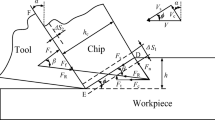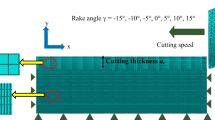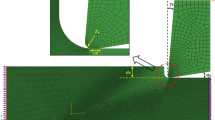Abstract
In the aircraft industry, Ti6Al4V is often used due to its good strength and excellent comprehensive performance. However, because of its particularity, the titanium alloy material itself makes the processing difficult. In the current research, the research on the force of machining, heat flow, and stress on machined surfaces produced when machining titanium alloy is not enough, especially for the residual stress has not been able to give a more accurate numerical solution. The main work of this essay includes the following: a planar orthogonal cutting model is established by finite element method (FEM), and the cutting mechanism is studied based on the established model. Combining previous work, the cutting temperature model was analyzed and the relationship between the distance from machined surface and residual temperature of the processed workpiece is discussed. Simulations are performed on the cutting temperature field under different processing conditions. Furthermore, on the basis of the model of cutting force and temperature, it was proposed that the residual stress versus depth curve can be an exponential function and a linear superposition of high-order Gaussian functions. This research has certain significance in revealing the mechanism of cutting force and residual stress formation in difficult-to-machine materials.








Similar content being viewed by others
Abbreviations
- \({\tau }_{s}\) :
-
Flow stress in primary shear band (MPa)
- \(\upvarepsilon\) :
-
Equivalent plastic strain
- \({\varepsilon }{\prime}\) :
-
Equivalent plastic strain rate (s−1)
- \({\varepsilon }_{0}{\prime}\) :
-
Equivalent plastic strain rate (s−1)
- \(\mathrm{T}\) :
-
Workpiece temperature \(\left(\mathrm{^\circ{\rm C} }\right)\)
- Tm :
-
Material melting temperature \(\left(\mathrm{^\circ{\rm C} }\right)\)
- Tr :
-
Room temperature \((\mathrm{^\circ{\rm C} })\)
- \({\gamma }_{o}\) :
-
Rake angle \(\left(^\circ \right)\)
- t:
-
Cut thickness (mm)
- rz :
-
Cutting edge radius (mm)
- \({F}_{\tau s}\) :
-
Resultant force (N)
- \({F}_{\tau }\) :
-
Shear force (N)
- \({F}_{\tau n}\) :
-
Normal force perpendicular to shear plane (N)
- \({F}_{f}\) :
-
Sliding friction force on tool-chip interface (N)
- \({F}_{n}\) :
-
Normal force perpendicular to back chip (N)
- \(\Phi\) :
-
Shear angle \((^\circ )\)
- \(\upbeta\) :
-
Friction angle \((^\circ )\)
- \({\alpha }_{p}\) :
-
Cutting depth (mm)
- tc :
-
Chip thickness (mm)
- Fc :
-
Cutting force (N)
- \(\mathrm{v}\) :
-
Cutting speed
- \({v}_{c}\) :
-
Chip flow velocity
- \({v}_{s}\) :
-
Shear velocity
- w:
-
Width of cutting (mm)
- h:
-
Thickness of primary shear band (mm)
- L:
-
Length of shear band (mm)
- \({T}_{M(x,z)}^{s}\) :
-
Total temperature rise of point M caused by the shear heat source \((\mathrm{^\circ{\rm C} })\)
- Tp :
-
Temperature rise of point M caused by the shear heat source \((\mathrm{^\circ{\rm C} })\)
- Ti :
-
Temperature rise of point M caused by imaginary heat source \(\left(\mathrm{^\circ{\rm C} }\right)\)
- B:
-
Fraction of shear plane heat conducted into workpiece
- qs :
-
Heat liberation intensity of shear plane
- \(\uplambda\) :
-
Thermal conductivity (w/(mm \(\mathrm{^\circ{\rm C} }\)))
- \(\mathrm{a}\) :
-
Thermal diffusivity (mm2/s)
- \({K}_{0}\) :
-
Modified Bessel function of second kind of order zero
- \({K}_{w}^{s}\) :
-
Dimensionless coefficient of modification of K0, corresponding to shear plane heat source
- \({\rho }_{s}\) :
-
Heating time of point M(x, z) due to shear plane heat source (s)
- \({\rho }_{f}\) :
-
Heating time of point M(x, z) due to tool flank-workpiece rubbing heat source (s)
- \({T}_{M(x,z)}^{F}\) :
-
Temperature rise of point M caused by the tool-workpiece friction heat source \((\mathrm{^\circ{\rm C} })\)
- \({q}_{F}\) :
-
Heat liberation intensity of tool-workpiece friction zone
- VB:
-
Width of tool-workpiece contact zone (mm)
- BF :
-
Fraction of tool-workpiece rubbing heat conducted into workpiece
- \({K}_{w}^{F}\) :
-
Dimensionless coefficient of modification of K0, corresponding to shear plane heat source
- \({T}_{M\left(x,z\right)}\) :
-
Final temperature rise of point M(x, z) \(\left(\mathrm{^\circ{\rm C} }\right)\)
- \({\sigma }^{f-mech}\) :
-
Stress due to cutting force
- \({\sigma }^{w-mech}\) :
-
Stress due to flank wear width
- \({\tau }^{f-mech}\) :
-
Shear stress due to cutting force
- \({\tau }^{mech}\) :
-
Shear stress due to flank wear width
- \({\sigma }^{mech}\) :
-
Stress due to thermal stress
References
Nurul Amin AKM, Ahmad FI, Nor Khairusshima MK (2007) Effectiveness of uncoated WC-Co and PCD inserts in end milling of titanium alloy Ti-6Al-4V. J Mater Process Technol 192(1):147–158
Wang XM, Li CH, Zhang YB, Ding WF, Yang M, Gao T, Cao HJ, Xu XF, Wang DZ, Said Z, Debnath S, Jamil M, Ali HM (2020) Vegetable oil-based nanofluid minimum quantity lubrication turning: academic review and perspectives. J Manuf Process 59:76–97
Chen FY, Wang DZ, Wu SJ (2021) Influence of ultrasonic vibration-assisted cutting on ploughing effect in cutting Ti6Al4V. Arch Civ Mech Eng 21:1–19
Chen GQ, Wu SJ, Wang DZ, Dai WQ (2022) Study on machinability of three-step drill in drilling Ti6Al4V. Proc IMechE Part B: J Eng Manuf 2022:1–13
Yao CF, Tan L, Yang P, Zhang DH (2018) Effects of tool orientation and surface curvature on surface integrity in ball end milling of TC17. Int J Adv Manuf Technol 94(1):1699–1710
Liu MZ, Li CH, Zhang YB, Yang M, Gao T, Cui X, Wang XM, Li HN, Said Z, Li RZ, Sharma S (2023) Analysis of grain tribology and improved grinding temperature model based on discrete heat source. Tribol Int 180:108196
Liu DW, Li CH, Dong L, Qin AG, Zhang YB, Yang M, Gao T, Wang XM, Liu MZ, Cui X, Ali HM, Sharma S (2022) Kinematics and improved surface roughness model in milling. Int J Adv Manuf Technol. https://doi.org/10.1007/s00170-022-10729-8
Ma K, Liu ZQ, Wang B, Zhang HM, Song QH, Liu H (2023) Insitu DIC measurement of material deformation through spatial–temporal kinematics analysis during orthogonal cutting Ti6Al4V. Measurement 207:112367
Bhirud NL, Gawande RR (2017) Measurement and prediction of cutting temperatures during dry milling: review and discussions. J Braz Soc Mech Sci Eng 39(1):5135–5158
Shan CW, Zhang X, Shen B, Zhang DH (2019) An improved analytical model of cutting temperature in orthogonal cutting of Ti6Al4V. Chin J Aeronaut 32(3):759–769
Fu Q, Wu SJ, Li CH, Xu JY, Wang DZ (2022) Delamination and chip breaking mechanism of orthogonal cutting CFRP/Ti6Al4V composite. J Manuf Process 73(2022):183–196
Zhang JJ, Wang DZ (2019) Investigations of tangential ultrasonic vibration turning of Ti6Al4V using finite element method. IntJ Mater Form 12:257–267
Wei L, Wang DZ (2022) Effect of ultrasound-assisted vibration on Ti-6Al-4V/Al2024-T351 laminated material processing with geometric tools. Int J Adv Manuf Technol 106:219–232
Wan L, Wang DZ (2015) Numerical analysis of the formation of the dead metal zone with different tools in orthogonal cutting. Simul Model Pract Theory 56(2015):1–15
Sun ZT, Shuang F, Ma W (2018) Investigations of Vibration Cutting Mechanisms of Ti6Al4V Alloy. Int J Mech Sci 148(1):510–530
Grissaa R, Zemzemi F, Fathallah R (2018) Three approaches for modeling residual stresses induced by orthogonal cutting of AISI316L. Int J Mech Sci 135(1):253–260
Jiang LL, Wang DZ (2019) * Finite-element-analysis of the effect of different wiper tool edge geometries during the hard turning of AISI 4340 steel. Simul Model Pract Theory 94:250–263
Pang K, Wang DZ (2020) Study on the performances of the drilling process of nickel-based superalloy Inconel 718 with differently micro-textured drilling tools. Int J Mech Sci 180:105658
Huang K, Yang WY (2016) Analytical model of temperature field in workpiece machined surface layer in orthogonal cutting. J Mater Process Technol 229(1):375–389
Karaguzela U, Budakb E (2018) Investigating effects of milling conditions on cutting temperatures through analytical and experimental methods. Journal of Materials Processing Tech 262(1):532–540
Möhring HC, Kushner V, Storchak M, Stehle T (2018) Temperature calculation in cutting zones. CIRP Ann Manuf Technol 67(1):61–64
Cheng H, Zhuang KJ, Weng J, Pu DL (2019) Three-dimensional analytical modeling of cutting temperature for round insert considering semi-infinite boundary and non-uniform heat partition. Int J Mech Sci 155(1):536–553
Wang P, Wang DZ (2020) Study on ultrasonic-assisted drilling of Ti6Al4V using 3-flute drill in the finite element simulation. Proc IMechE Part C: J Mech Eng Sci 234(7):1298–1310
Wang SQ, Li JG, He CL, Laghari RA (2019) An analytical model of residual stress in orthogonal cutting based on the radial return method. J Mater Process Tech 273:116234
Wan L, Wang DZ, Gao YY (2015) Investigations on the effects of different tool edge geometries in the finite element simulation of machining. Strojniški Vestnik - J Mech Eng 61(3):157–166
Wang DZ, Wu SJ, Wang GQ, Okubo S (2015) Model tracking controller design of robot manipulator system with disturbances. Adv Mech Eng 7(7):1–9
Wang P, Wang DZ (2020) Evaluation of different tool geometries in the finite element simulation of ultrasonic-assisted drilling of Ti6A14V. J Braz Soc Mech Sci Eng 42:181
Huang K, Yang WY (2016) Analytical modeling of residual stress formation in workpiece material due to cutting. Int J Mech Sci 114(1):21–34
Ma Y, Feng PF, Zhang JF, Wu ZJ, Yu DW (2016) Prediction of surface residual stress after end milling based on cutting force and temperature. J Mater Process Technol 235:41–48
Nespor D, Denkena B, Grove T, Böβ V (2015) Differences and similarities between the induced residual stresses after ball end milling and orthogonal cutting of Ti-6Al-4V. J Mater Process Technol 226:15–24
Wang DZ, Lu Y, Hang TC, Wang KY, Rinoshika A (2015) Effect of stiffness of rolling joints on the dynamic characteristic of ball screw feed systems in a milling machine. Shock Vib 2015:697540
Wei L, Wang DZ (2019) Comparative study on drilling effect between conventional drilling and ultrasonic-assisted drilling of Ti-6Al-4V/Al2024-T351 laminated material. Int J Adv Manuf Technol 103:141–152
Wan L, Wang DZ, Gao YY (2016) The investigation of mechanism of serrated chip formation under different cutting speeds. Int J Adv Manuf Technol 82:951–959
Buchkremer S, Klocke F (2016) Compilation of a thermodynamics based process signature for the formation of residual surface stresses in metal cutting. Wear 376:1156–1163
Duan ZJ, Li CH, Ding WF, ZhangYB YM, Gao T, Cao HJ, Xu XF, Wang DZ, Mao C, Li HN, Kumar GM, Said Z, Debnath S, Jamil M, Ali HM (2021) Milling force model for aviation aluminum alloy: academic insight and perspective analysis. Chin J Mech Eng 34:18
Huang BT, Li CH, Zhang YB, Ding WF, Yang M, Yang YY, Zhai H, Xu XF, Wang DZ, Debnath SJ, Jamil M, Li HN, Ali HM, Gupta MK, Said Z (2021) Advances in fabrication of ceramic corundum abrasives based on sol–gel process. Chin J Aeronaut 34(6):1–17
Cui X, Li CH, Ding WF, Chen Y, Mao C, Xu XF, Liu B, Wang DZ, Li HN, Zhang YB, Said Z, Debnath SJ, Jamil M, Ali HM, Sharm S (2022) Minimum quantity lubrication machining of aeronautical materials using carbon group nanolubricant: from mechanisms to application. Chin J Aeronaut 35(11):85–112
Andrade UR, Meyers MA, Vecchio KS, Chokshi AH (1994) Dynamic recrystallization in high-strain, high-strain-rate plastic deformation of copper. Acta Metal Mater 42(9):3183–3195
Baker M, Rosler J, Siemers C (2002) A finite element model of high speed metal cutting with adiabatic shearing. Comput Struct 80(5–6):495–513
Calamaz M, Coupard D, Girot F (2008) A new material model for 2D numerical simulation of serrated chip formation when machining titanium alloy Ti-6Al-4V. Int J Mach Tools Manuf 48(3–4):275–288
Ducobu F, Rivière-Lorphèvre E, Filippi E (2017) On the importance of the choice of the parameters of the Johnson-Cook constitutive model and their influence on the results of a Ti6Al4V orthogonal cutting model. Int J Mech Sci 122:143–155
Wang JF, Zuo JF (2019) Modeling of cutting force prediction in machininghigh-volume SiCp/Al composites. Appl Math Model 70:1–17
Moufki A, Molinari A, Dudzinski D (1998) Modelling of orthogonal cutting with a temperature dependent friction law. J Mech Phys Solids 46(10):2103–2138
Bai W, Sun RL (2017) Improved analytical prediction of chip formation in orthogonal cutting of titanium alloy Ti6Al4V. Int J Mech Sci 133:357–367
Ye GG, Xue SF, Jiang MQ, Tong XH, Dai LH (2013) Modeling periodic adiabatic shear band evolution during high speed machining Ti6Al4V alloy. Int J Plast 40:39–55
Cotterell M, Byrne G (2008) Characterisation of chip formation during orthogonal cutting of titanium alloy Ti6Al4V. CIRP J Manuf Sci Technol 1(2):81–85
Hou Z, Komanduri R (2000) General solutions for stationary/moving plane heat source problems in manufacturing and tribology. Int J Heat Mass Transfer 43(10):1679–1698
Yan L, Yang WY, Jin HP, Wang ZG (2012) Analytical modeling of the effect of the tool flank wear width on the residual stress distribution. Mach Sci Technol 16(2):265–286
Smithey DW, Kapoor SG, DeVor RE (2001) A new mechanistic model for predicting worn tool cutting forces. Mach Sci Technol 5(1):23–42
Lee S, Lin CF (1998) High-temperature deformation behavior of Ti6Al4V alloy evaluated by high strain-rate compression tests. J Mater Process Technol 75(1–3):127–136
Funding
This study was supported by a research project financed by the National Natural Science Foundation of China (Number 5217052158).
Author information
Authors and Affiliations
Contributions
Conceptualization, Shujing Wu; software, Feiyang Chen and Dazhong Wang; editing, Guoqiang Wang; writing review, Change Li and Jinzhong Lu. All authors have read and agreed to the published version of the manuscript.
Corresponding author
Ethics declarations
Competing interests
The authors declare no competing interests.
Additional information
Publisher's note
Springer Nature remains neutral with regard to jurisdictional claims in published maps and institutional affiliations.
Rights and permissions
Springer Nature or its licensor (e.g. a society or other partner) holds exclusive rights to this article under a publishing agreement with the author(s) or other rightsholder(s); author self-archiving of the accepted manuscript version of this article is solely governed by the terms of such publishing agreement and applicable law.
About this article
Cite this article
Wu, S., Chen, F., Wang, D. et al. Machining mechanism and stress model in cutting Ti6Al4V. Int J Adv Manuf Technol 131, 2625–2639 (2024). https://doi.org/10.1007/s00170-023-11941-w
Received:
Accepted:
Published:
Issue Date:
DOI: https://doi.org/10.1007/s00170-023-11941-w




